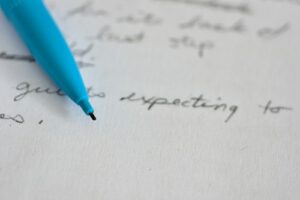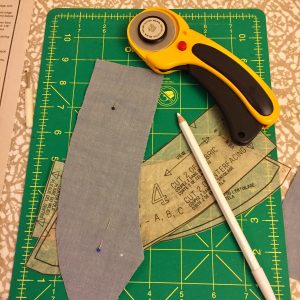Process
Sometimes the shortest things can unexpectedly be the hardest to write. And that’s the case with author biographies, or bios for short. Bios aren’t like CVs. They’re not as formal. They are more like mini-stories. They give a flavour of the person behind them. And like query letters and blurbs, they function as ‘hooks.’
Over the course of a writing career, you’ll discover you need more than one bio. In fact, you might find that you need quite a few. Each of them will be written for particular purposes, whether that be pitching for genre-specific projects, for festivals and conferences, or for book proposals and blurbs. Each of them will have a slightly different angle, though they encapsulate the same basic biographical and bibliographical information. And though they may fall into ‘types’ of bios—ie, for publication, presentation or industry purposes—each bio is also slightly different, even within each type.
The Case of Valerie May
For a bit of fun, let’s take the (imaginary) case of Valerie May, author of romantic suspense novels who also writes the occasional non-fiction authorship book. Here are a couple of her pitch bios, one for a non-fiction book called Roses have Thorns, a practical guide to maintaining a writing career, and the other for her new novel, The Jade Peacock.
Bio A: Valerie May is the award-winning author of fifteen novels, including the internationally bestselling The Black Rose. She is the founder of Delicious Shivers, a popular blog specialising in the romantic suspense genre, and with fellow author Jenna Sims initiated the first Delicious Shivers seminar, now an annual event. Over the course of her career, Valerie May has been a bookseller, served on several literary industry committees, and been a popular speaker at conferences and festivals.
Bio B: Born in London of an Irish father and French-Vietnamese mother, Valerie May was brought up between languages and cultures and now lives in Sydney, Australia, with her family. The award-winning author of fifteen novels of romantic suspense, including the bestseller The Black Rose and its popular sequel, By Any Other Name, as well as three works of non-fiction, she also blogs regularly, and features as a speaker at literary events. Her Vietnamese grandmother’s dramatic story was the inspiration for The Jade Peacock.
These two bios have a similar structure, but a different emphasis, with each aimed at establishing Valerie’s credentials in a particular context . For Roses have Thorns, the emphasis is on Valerie’s professional experience in the book industry; but for The Jade Peacock, the bio takes in not only her track record as a writer, but also a great deal more personal information, including her cultural background which is relevant in this case. In both, the fact that she is a successful professional author is front and centre, but in the novel bio, there is a more private angle as well, allowing the reader to relate to the author as a person. Meanwhile, for the non-fiction book, her experience of the industry from different professional points of view–author, blogger and bookseller–is highlighted, and more personal information is omitted.
By the way, it’s my opinion that it’s best to write bios in third person, and to stay away from quirky bios.
Read More“I often think that the best writing is done after you’ve forgotten what you wanted to say, but end up putting something down anyway just as though it were the actual evidence of your original intention.” Clarence Major
Has this happened to you? When you sit down to write, the idea won’t come, the original thought stalls. The words are stuck in your finger’s throat. But if you keep writing, put down the words that do come, soon something else emerges, something that does work and that you can be excited about.
Then, follow that new thought without letting the original thought tie you to a metaphorical iron post, simple (and as complicated) as that.
Sometimes our mind is changed before even we know it needs to be changed. There are many times when we must follow where we are led. What a journey! This is living, folks. This is writing. This is manipulating the language and story without constant constraint—ah.
“The use of point of view is to bring the reader into immediate and continuous contact with the heart of the story and sustain him there.” Tom Jenks
Your reader will see, feel/experience, and be through the “eyes” of the character who speaks. To me, the characters are not just the heart of the story, they are the story. My characters spark my imagination, and along with my setting (a whole other character, actually), they give me joy in my writing. As your characters should for you, or some variation of that feeling.
Consider photography. When I have the camera, I am the controller of that camera lens. I see and interpret through the lens and then I take snapshots so that others may see, or experience, what I have seen and experienced. Until I share the image I have captured, no one can know what I am thinking or feeling. I show them. I tell them.
If I hand the camera to George, he then sees everything through his own eyes/interpretations. I can’t know what he sees and what he is thinking, what has captured his imagination/interest, until he relays it to me by showing me the photo, and as well tells me about it—and through both the showing and the telling, I see and experience through his eyes/his experience.
We writers have the beautiful opportunity to give readers, through our character’s point of view, experiences that they can relate to, but also to allow our readers unique experiences through as many ways as we want to write.
“Surely the test of a novel’s characters is that you feel a strong interest in them and their affairs—the good to be successful, the bad to suffer failure.” Mark Twain
If you are not interested in your characters and what they do and say and are, why should anyone else be interested? If you do not believe in your work, why should anyone else believe in your work? Believe me, it will show. The reader always knows.
Give readers your best. Give readers your heart. Give readers your interest. Give them the truths—and this word “truth” may mean more than what first appears to you. Writing what you […]
Read MoreImage by Karen Roe
Well, I’m home from book tour! And leaving again in a few days. I try to group events together to make travel (and child care) easier, but these things can be difficult to wrangle precisely. So a month after I visited five states from Wisconsin to Alabama promoting Girl in Disguise, I’m headed out to four more (Iowa, here I come!).
I’ve found the advice of fellow touring authors from my previous tour-tips roundup invaluable on my travels, and since I received more suggestions than I could fit in a single post, I’ve got more to share with you! Without further ado, more brilliant ideas for authors on tour.
Alex George, on the road with his new book Setting Free the Kites, has two pieces of advice, both related to signing books:
Amy Stewart, recently back from a tour on the other side of the world in Australia and also all over the map here in the US, has great tips for staying well and doing good:
Read MoreI recently found myself on Oprah.com listening to Dr. Brené Brown explain the difference between guilt and shame. If you have two minutes and fifty-two seconds, this video is worth your while.
In summary: Guilt is the recognition that we made a mistake and we need to do better. Shame is a label or identity we take on as a result of a mistake. For example, if I lose my temper with my teenaged son and end up calling him an idiot (hypothetically speaking, of course), guilt would lead me to recognize it wasn’t my best parenting moment, and I need to apologize. Shame would lead me to call myself a bad mother. It’s clear which is the desired state.
What is frightening, however, is not only how easy it is to slip into a “shame cycle,” but also the correlation between shame and addiction, mental illness, and other serious issues. Examining how we cope with problems when they arise in every aspect of our lives is critical to our relationships and mental health. As writers, it is also important we examine our reaction to setbacks in the creative realm with a healthy response.
Rejection
If you are a writer, rejection is a certainty. Every single writer at every single step of the process has and will experience it. From teachers, to critique partners, to agents, editors, reviewers, and the reading public, wanted and unwanted feedback is as ingrained in the work as pen and paper. Those authors who make a career out of writing aren’t necessarily more talented than unpublished writers, but they are more stubborn. More positively: they adapt and move on. They understand rejection is not personal, or the work isn’t ready, or the timing isn’t right. Instead of labeling themselves “bad writers,” they revise the work, make changes in their presentation, or write a new book.
History
Our internal voices probably have a lot to do with how we were raised. Were our parents, teachers, and other adults in our lives encouraging, open, honest, and trustworthy, or did we grow up in a home where we were put down, told we were no good, or witnesses to bullies and victims? I was fortunate. My parents were supporting and loving people. It is likely easier for me to understand failure is a detour and not a stop sign. But during periods of darkness, the demons of shame are hard for anyone to overcome.
Read More
Let’s say I’m writing a novel. Heck, let’s say I’m rewriting it. And let’s say this process is taking me an ungodly long time. How long? Let’s not get bogged down in details. This is all theoretical, anyway. I’m hypothesizing for a friend.
Why, fellow unpublished novelist, might this rewrite be taking so long? There are so many reasons: kids, home, work, aging parents, democracy, volunteering in your community, etc. If you want to publish, yes, you need commitment. But you also can’t ignore the rest of your world. Throw in a few life crises, and the process of writing a novel can start to feel like it contains more chapters than the novel itself. Raising a kid? That only takes eighteen years. But a novel is forever.
So what do you do when you feel like every writer you know has finished her seven-book series while you’re still struggling with your debut (or maybe your second or third book)? First, stop beating yourself up. It’s okay. Second, recognize that this abundance of time is an opportunity, especially if you’re unpublished. If you don’t have an agent and publisher tapping their fingers on their desks, expecting you to meet a contractual deadline, then use this time to work on your craft and get that novel right. If all goes well, you may not have this kind of time in the future.
Third, be prepared. If you’re traveling the long road to finishing a book, you may run into a specific set of problems, one or more of which undoubtedly involve you questioning your own sanity. Let’s examine some of these potential anti-speed traps, and see if there’s anything we can do about them.
The gnawing plot problem
You’ve come to a tricky plot point in the middle of your manuscript, and the problem is exacerbated because you can’t give it your undivided attention. Here’s the trap: you’ll solve this problem. Then you’ll solve it again. And again. In fact, you’ll come up with so many solutions to this problem and have so much time to consider each one while you’re tending to your other obligations that you’ll decide each solution seems too contrived to be usable. If it’s not contrived, it’s too obvious, as evidenced by the fact that you thought of it. This is true even if in your literary historical novel set during the American Revolution, it occurs to you that aliens from the Vega star system could thwart the British before they capture the young Patriot by guiding said Patriot to the cache of laser-powered muskets. Duh. Anyone would see that coming.
The solution? Realize it’s possible your perspective has become skewed over time. Yes, you’ve thrown out at least fifty possible plot points. But hopefully you kept a few of the better ones in a “scraps” file somewhere, because chances are at least one of them contained a nugget of something good.
Read Morehttps://www.youtube.com/watch?v=mKYrAtIP-Ro
I’ve just blasted through the first act of my new work in progress. It was like falling in love again, my passion ablaze for this new subject and new characters. My fingers flew over the keys and the exhilaration of creating had me in its grip—until I got THERE. You know the “there” I’m talking about. That point when you realize you’ve laid all the groundwork you need, and it’s time to start making things happen. This is where the stakes must rise and the character really starts to unravel. It’s the place where I down-shift from fifth gear to first, and suddenly feel as if I’m wading through waist-deep mud.
At this stage, the “shiny new idea” has lost some of its luster. Those perfect and lofty concepts of story have suddenly morphed from glorious, inspired musings to basic building blocks: word count, paragraphs, dangling participles, bad grammar. GAH! Yeah, that’s all part of it, but the other big issue is the psychological mind f*ck that happens during the long, rambling second act. The characters seem to all sound the same, the plot feels flimsy and unbelievable, and the descriptions awkward. My confidence drains away and I start to feel like a total hack. I begin to question myself. Should I scrap these pathetic pages? Is this novel complete tripe? Does it even have a point? NO ONE WILL READ THIS CRAP.
I sink deeply into that mud. In a moment of desperation, I dial a writer friend! Invariably the conversation goes something like this:
Read MoreBy Wally Gobetz, Flickr’s CC
Please welcome Maya Rock as our guest today. In 2010, she founded Fresh Ink Book Editing to offer editorial support to agents, authors, and publishing houses. She graduated from Princeton University in 2002 and has worked in book publishing ever since. Prior to Fresh Ink Editing, she started at Anderson Grinberg Literary Management, then moved to Writers House, where she agented for four years.
As an editor, I’ve helped many writers through the revisions process and have noticed that it can be challenging for them. There’s not as much glory in revising as in just having a completed draft or book, and they’re often unprepared for how much time it will take. I thought sharing some of my insights on the process might help.
Connect with Maya on her website, her blog, and on Facebook.
The Emotional Roller Coaster Of Revisions
All writers experience fears when handing over a manuscript to an editor, from potential distress upon receiving edits, to the nerves of getting on the phone and talking it all over, and finally to the feeling of being overwhelmed while implementing changes. Being able to anticipate your emotions during a revision will make this process go more smoothly.
Step One, Fear: Handing Over The Manuscript
You may be scared to hand over your manuscript to an editor. Not only have you invested a lot of time on the project, you may feel, on some level, that you’re showing your soul. You’re vulnerable. How can this fear be lessened?
Step Two, Distress: Receiving Edits
You knew that you are going to get feedback. You may have even asked that the editor be ruthless. Yet actually seeing the feedback is causing some uncomfortable feelings and thought. There’s just […]
Read MoreBy Mary Constance, Flickr CC
Please welcome guest Judy Fogarty who lives, writes, reads, and runs on the historic Isle of Hope in her native Savannah, Georgia. She holds a Master of Music degree in Vocal Performance and Literature from the University of Illinois and has served as marketing director for private golf and tennis communities in the Savannah/Hilton Head area, including The Landings on Skidaway Island, Berkeley Hall, and Callawassie Island. She is a devoted—even rowdy—tennis fan, as anyone who has had the pleasure—or displeasure—of watching a professional match with her will attest. Breaking and Holding is Judy’s debut novel. She is happily at work on her second, enjoying as always the invaluable support of her husband, Mike, and children, Colin and Sara Jane.
Breaking and Holding traveled a long, tedious road to publication with too many revisions and disappointments to count. The novel wouldn’t be in print today were it not for the wisdom, encouragement, and camaraderie of my writing group, The Savannah Scribes. Every serious writer deserves the same kind of unfailing support, and I’d love to help others find it.
Connect with Judy on Twitter and on Facebook.
A Writing Group that Works
One writing group. Four years together. Six women working in different genres. And since August 2016: three novels sold (two already published and the third scheduled for June); a non-fiction book deal signed with a major university press; an extensive essay published; and a memoir currently in submission to agents.
What factors have contributed to the success of the Savannah Scribes? Perhaps it’s one of our mascots: Penny Lane, a Pomeranian; Gussie, a Boston Terrier; or even Gus, a pig. Perhaps it’s brain-food: the homemade chicken and dumplings we love. Maybe it’s the mornings after our meetings and the emails we write, in which we sound like we’re gushing but are totally sincere in thanking each other for wisdom and feedback.
Though all of those are possibilities, here are a dozen other criteria that you may find helpful in sustaining, improving or establishing a writing group.
Read More
A Revealing Scene (in more ways than one)
I stumbled upon something unexpected recently while working on the opening for a potential work in progress. It turns out my protagonist has a son. Well, I suppose that in itself wasn’t a shock. After all, I was the one who placed the youth amidst the brief bridging conflict, having him tag along as an inquisitive preteen might do while his father checks a glitch in the security perimeter for the isolated town in which they live after the collapse of a once great land. The surprise was the realization that this awkward, questioning boy was the center of my protagonist’s world, meaning more to him than his wife, more than his standing in the community, more in fact than he himself will see until much later in the story. And it was in that moment of discovery that all the machinations for the tale I had plotted out in my head instantly fell into place. For I had identified the primary motivator of my lead, and pinpointed a relationship I would need to tease out and understand, just as surely as any individual character arc.
Only later did it occur to me I had experienced a similar epiphany on my first novel, when the protagonist’s relationship with his brother, though not central to the story, had proven key to understanding his past, and an essential thread in his evolution.
Both observations got me thinking about character relationships, from those that bloom in plain sight, like Ove’s thawing relationship with his neighbor Parvaneh over the course of Fredrik Backman’s A Man Called Ove, to subtle ones that sneak up on readers and characters alike, such as Ove’s grandfatherly affection for Parvaneh’s daughter in the same tale. Specifically, I wondered this – What are the keys to crafting realistic and moving relationships between characters? And what are the tools one can use to give those relationships their due, supplying them with the power not only to shape the protagonist’s emotional arc but also to elevate the entire work?
Read MoreFlickr Creative Commons: Bruce Guenter
An interesting thing has been happening to me with increased frequency: I’ve been asked to read friends’ and acquaintances’ manuscripts as a sensitivity reader for stories that deal with immigration. Because I am a Latina and an immigrant, and the authors who’ve requested I read their work are writing outside of their own experience, I’ve been asked to evaluate their work for authenticity. So far, I’ve had to turn down these kinds of requests because I’ve been busy with my own writing and mentoring work, not to mention personal commitments. But while I am not actively offering sensitivity reading as a service, there are several writers and editors who are. As sensitivity readers become more sought after in the publishing world, their role has been met with mixed reactions.
First Things First: What Is a Sensitivity Read?
A sensitivity read is an evaluation of a manuscript, usually one that touches upon characters and experiences of a marginalized group of people, that is performed by someone within that group to bring attention to potential inaccuracies, biases, and reinforcements of harmful stereotypes. Much like one might ask a cardiologist to read their story about a cardiologist for accuracy, a sensitivity read helps ensure that the portrayal of characters and worlds unknown to the author ring true. But more than that, it helps authors better yield the immense power and responsibility of their words. How many of us write because we want to make sense of the world around us? And more importantly, how many readers seek out our work in search of stories and truths that will, inadvertently or not, shape how they see the world?
This kind of work takes, well…work, at every stage of the process. There’s pre-writing research, there are revelations we experience during the writing itself. Post-writing, a sensitivity read provides yet another crucial layer of learning to the process. And yet, some authors continue to resist (and resent) the very idea of one.
Maybe it’s the name. The word “sensitive” has gotten a bad wrap lately, too often used to accuse someone of being too touchy or emotional. Perhaps the real question writers should be asking is: am I being sensitive enough? Am I using my senses to foster acute awareness and concern for the complexities of what I’m writing about? Isn’t that part of our job as writers?
Maybe it’s how it’s described. A recent story titled “Publishers are hiring ‘sensitivity readers’ to flag potentially offensive content” included an unfortunate word choice in the headline alone. The main purpose of a sensitivity read is not to avoid offending; it’s to avoid harming. If you’re writing about a person who is marginalized or underrepresented, understand the weight of what that means—for readers who rarely see their experiences reflected in books, seeing negative or erroneous stereotypes reinforced can be hurtful to them and their community. For readers outside of that experience, yours may be one of the few stories about a disabled or gay or black person that they read for years. Books carry authority; they have a way of seeming […]
Read MoreSome days when I’m writing, I wake up in the middle of the night and can’t fall back to sleep because I feel like an entire swath of my story– a scene, a chapter, sometimes even more– has just been downloaded into my head. My mind is so filled with lines of dialogue, descriptions, and plot points that I can almost feel my brain creaking trying to hold it all, and when I sit down with my computer my fingers fly over the keys, frantically trying to capture everything that’s so crystal clear in my imagination. I call those times visits from the muse (even though yes,I know, muses are really just manifestations of the authors unconscious mind, etc. etc). Regardless of where it comes from, it feels like magic. It’s the way we always want to feel when we write.
Although before I get to the heart of this post, I do want to say one thing. Yes, the visits from the muse are great, but I have other writing days where my children interrupt me 600 times in twenty minutes, or I have a cold or some other real-life intrusion, every paragraph feels like a chore, every page is a slog, and I will literally stop writing mid-sentence just because I’ve finally hit my word-count goal for the day. And then again somewhere in the middle, I have other days when I know exactly how I want the story to play out, but it still takes forever to write because I somehow can’t quite find the words to match what’s in my mind. And you know what? At the end of the day, when the story is all finished, I honestly can’t tell which chapters were written on which types of writing days. Nor, I don’t think, can anyone else. I get just about the same number of editorial compliments and criticisms on scenes that were written on pulling-teeth kinds of days as I do on the writing that happened during a visit from the muse. The muse isn’t the be all and end all, is what I’m saying, and if she’s just not showing up for you, don’t despair. I honestly think that just your showing up and writing each day, no matter what, is the single most important component of what makes a successful author.
That said, though, it’s easier (not easy, but easier) writing when the muse is willing to pay us a call. And magic or the unconscious mind, I do think we can, to a degree, make those visits more likely to happen. So here are my top three favorite strategies:
Read MoreThe best idea I had for my first book came while I was raking leaves the backyard with my dog and realized that my main character also needed a dog. And then, to the soothing sounds of my rake scratching through the grass while I gathered cottonwood leaves into piles, I worked through the all the ways my character could and couldn’t acquire her new best friend. When I sat down to write, I knew exactly what she would do.
Back then, I had lots of time to think things through. Social media wasn’t a big deal yet. Streaming video wasn’t a thing. My phone only made phone calls. There was much blank headspace to be had. Even when I had a full calendar, I still got stuck in line at the post office, and we did not yet have the technology to tweet about it. My writing time felt like downloading. I’d write eight pages for writing group in a few hours on a Sunday night, because I’d spent all week thinking about it.
But the internet took over. It got too easy to fill downtime. Not just in hedonistic ways. I do most of my research via audiobook when I’m walking or cleaning, and I’m grateful to be able to learn while I’m in motion. But my free thought time has become jam-packed with structured thought. With other people’s thoughts. While I was vaguely aware of this, and somewhat troubled by it in a distant, nagging way, I didn’t realize how much of a problem all the noise was until I started sewing.
Read MoreI’ve gotten a bit of a reputation with dinner guests at my house. If they like something I serve, they’ll ask for a recipe. My answer is the same about 97 percent of the time: “Well, there’s not really a recipe, exactly….”
When I cook, I never follow instructions. I meld and blend, pulling a technique from one recipe and ingredient list from another, plus a half a handful of something else I want to use up before it goes bad, and a last-minute substitution of something I actually have for something I thought I had, but didn’t. I made a Chinese cumin lamb stir-fry for dinner tonight, except I used beef instead of lamb, swapped the crispy coating for a marinade of soy sauce and sesame oil and ginger, cut the cumin in half, added shiitake mushrooms, deglazed the pan partway through with some rice wine vinegar, and half-decided/half-forgot to put in the hot dried peppers. Was it still delicious? Yes. Was it what the recipe writers at the New York Times had in mind? Not even remotely.
I write the same way. I have tried many times to use an outline. My outlines seem logical and perfectly well thought-out, and I use them to start writing, but the only variation is whether I jump ship midway through the first draft or whether I have to write the whole thing to see how wrong it is. I add and subtract characters. I recognize the beginnings of subplots and themes I didn’t actually put in on purpose, and rewrite to make them stronger. No matter how much thinking and planning I do beforehand, I change my plans while I’m putting the words down on the page for real. Writing helps me discover my own intent.
Read More




















